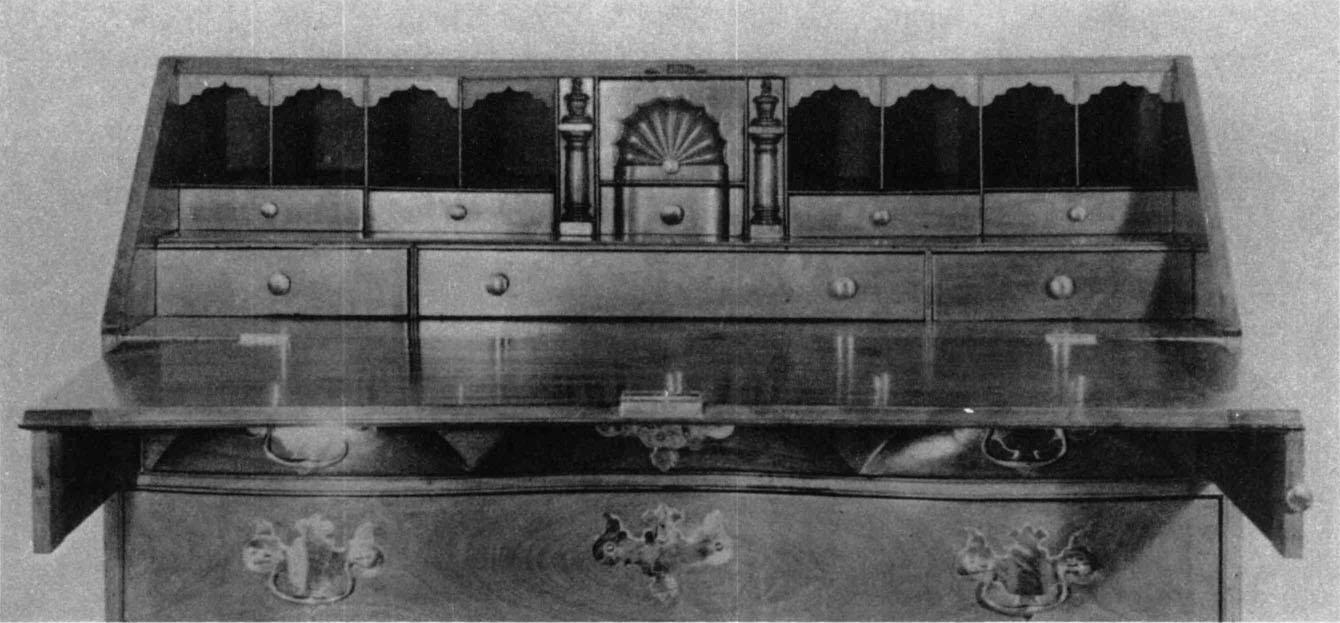Benjamin Frothingham
SO few American cabinetmakers have left behind a broad variety of signed work that the picture of normal daily production cannot be easily examined by the student. William Savery of Philadelphia, John Townsend of Newport, and Benjamin Frothingham of Charlestown are three major exceptions in the eighteenth century, each having liberally labelled his furniture, while others as competent did not seem to do so. Among the many famous cabinetmakers of Boston, like John Cogswell, George Bright, and Ebenezer Hartshorne, sometimes only one or two pieces have retained signatures or maker’s marks, while in the case of Alexander Edwards, who paid as high a tax as Bright, not a single example is known. The signed furniture of Benjamin Frothingham is, therefore, worth considering as giving the broadest view of a typical workshop of the Boston region in the eighteenth century.
Benjamin Frothingham (April 6, 1734 – August 19, 1809) was the son of the joiner Benjamin Frothingham (1708–1765) of Boston. The father had a shop in Milk Street, recorded to have burned in the great fire of March 20, 1760, and presumably the younger Benjamin was trained in that shop. In 1756, our Benjamin Frothingham bought a parcel of land in Charlestown where he seems to have been established from at least 1754 until his death in 1809.204 At the time of the Revolution, his shop in Walker Street was one of twenty-nine cabinetmakers’ establishments which were destroyed when the town of Charlestown was burned by the British on June 17, 1775. He was a member of Captain Gridley’s militia from 1754 and served in the Revolution becoming a major by war’s end. He retained the title of “Major” all his life, and it has often been noted that George Washington visited Frothingham, “whom he had known in the army,” in 1789 in Charlestown. The cabinetmaker was also a member of the Society of the Cincinnati.205 His wife was Mary Deland by whom he had seven children, one of whom, Benjamin (born 1774), followed the family trade.
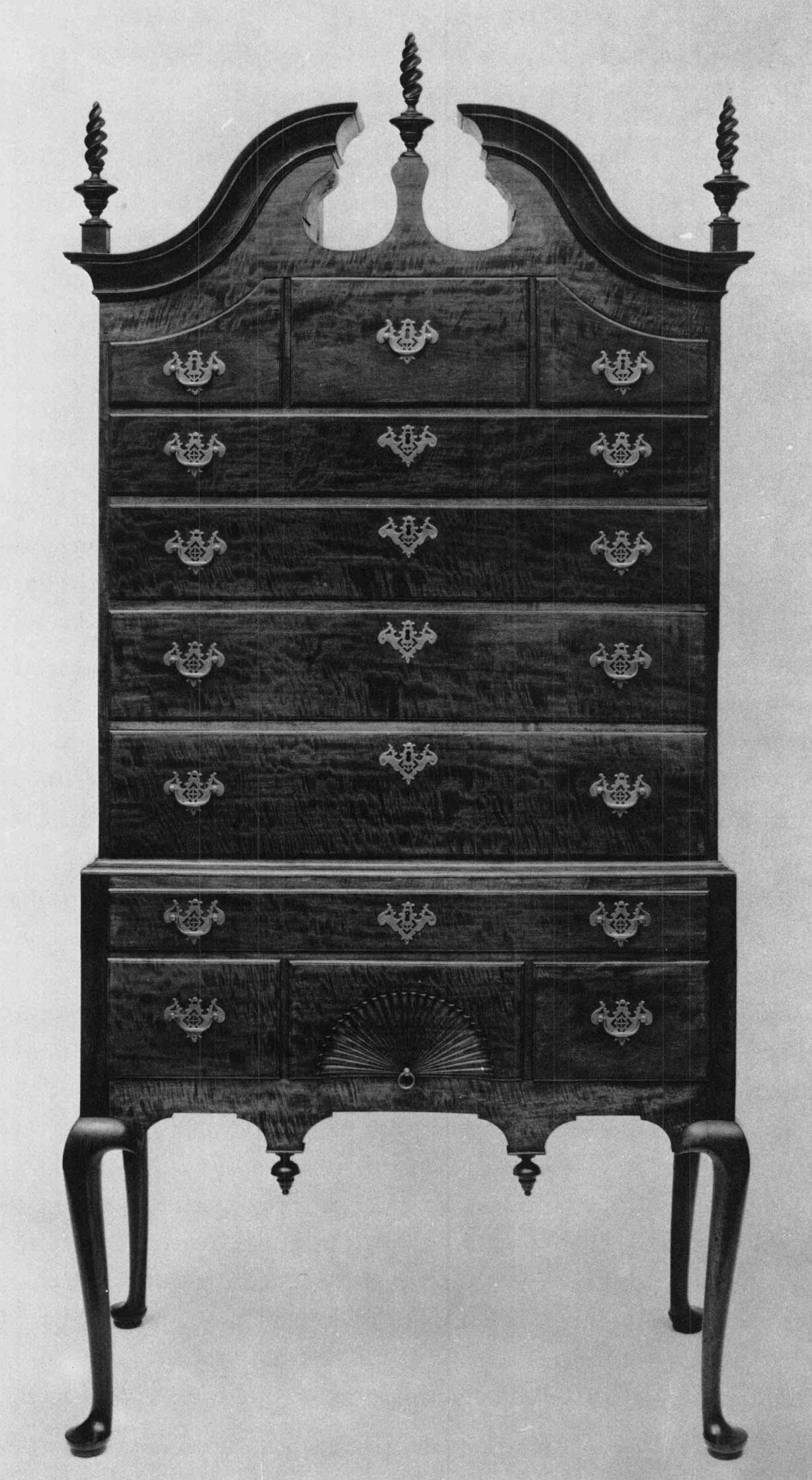
154. High Chest. Made by Benjamin Frothingham (signature in chalk), Charlestown, c. 1755–1790. Mahogany and white pine; h. 87⅜ inches, w. 42 inches, D. 22⅛ inches. (The Henry Francis du Pont Winterthur Museum.) This chest and matching dressing table (fig. 155) may have been owned by Nathaniel Richards (1712–1788), an innholder and saddler of Roxbury. His name appears in chalk on the bottom of the long drawer in the lower section.
The example of John Townsend’s labelled furniture gives fair warning to all who would date furniture purely on the basis of style, since his work includes pieces in the styles of the mid-century dated in the 1790s. His three-shell chest in the Metropolitan Museum (fig. 49) is dated 1765, for instance, and a second labelled three-shell chest, now in the State Department, is dated 1792.206 There are minor concessions to the new neoclassicism, in the choice of plain bail handles and a slight change of proportion and lightening of the moldings of the top, but the answer to dating furniture probably lies in the taste of the man who commissioned it, not in the taste of the cabinetmaker.
Hence, the furniture of Frothingham to be examined is placed in the order of stylistic sequence for simplicity, with no intention of implying dates, early or late. The first examples to consider are in the pad-foot cabriole style of the mid-century.207 There is a dressing table and matching high chest of drawers, now in the Winterthur Museum and formerly in the Charles K. Davis Collection, with simple cabriole legs and “plain feet,” as they were called (figs. 154 and 155). Each piece has a nicely executed fan in one drawer, the proportions are good, and the high chest terminates in a well-shaped bonnet with three corkscrew finials. The pieces are made of an unusual burl wood, formerly called curly walnut, but now identified as a type of plum pudding mahogany. The wood is very beautiful and gives considerable interest to the surface, as do the pierced fret brasses on the drawers. Two of the brasses are unusual in that they are stamped clearly on the lower edge of the face “I. Gold,” presumably the name of the maker or supplier. Interior construction is of white pine throughout. One drawer in the high chest is signed in chalk: “Benjamin Frothingham” and “Nathanael Richards” (probably the name of the owner).208
In the cabriole style are two examples at Winterthur having claw feet with raked talons, typical of the Boston region. One is a card table with reverse blocked sides, nicely emphasizing the corners of the table and accommodating the candle pockets (fig. 156). The legs are long and lean with a sophisticated curve and unusually delicate ankles. The piece is labelled in the drawer with one of the labels engraved for Frothingham by Nathaniel Hurd, the silversmith of Boston (fig. 157). Its secondary woods are white pine and maple.209
The second claw table at Winterthur is unusual in itself, since so few of the type survive (fig. 158). It is a six-legged claw foot dining table with two swinging gates to support each large leaf. It is built of light-hued mahogany with white pine and maple as its secondary woods, and is labelled beneath with Hurd’s paper label. The legs are well shaped, but not as delicate as those of the card table, nor are the carved talons as acutely raked.210
Two secretaries with plain bracket feet number among Frothingham’s labelled works. One is made of cherry, an unusual wood in Boston-area practice, and was formerly in the collection of Ernest Lo Nano (fig. 159). The base has a straight front, and the bookcase top has doors with fielded panels terminating in flattened arches. The bonnet top resembles the Winterthur high chest with three corkscrew finials. The interior of the bookcase is divided into eight compartments with two rows of eight ogee-headed pigeonholes above. The desk interior has three reverse blocked sections, containing drawers at each end and a central door, each carved with a fan at the top (fig. 160). These, like the fans of the Davis-Winterthur examples, have a notched or as it is sometimes called a “thumbprint” profile. There are two round-headed pigeonholes between, with a blocked drawer below. The bracket feet have a simple single spur for decoration.211
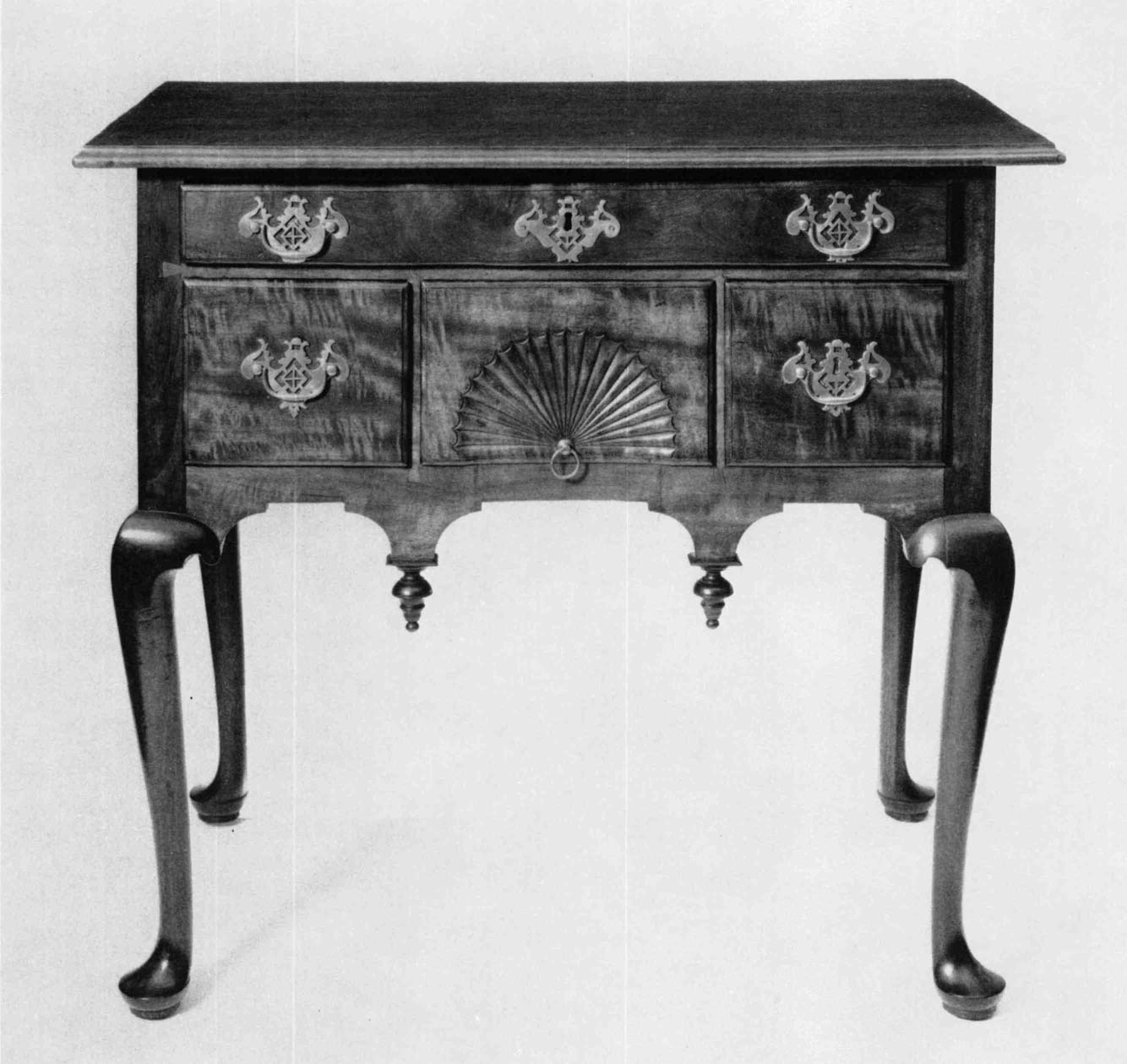
155. Dressing Table. Attributed to Benjamin Frothingham, Charlestown, c. 1755–1790. Mahogany and white pine; h. 31½ inches, w. 33⅞ inches, d. 20¾ inches. (The Henry Francis du Pont Winterthur Museum.) This table is a mate to the chest illustrated in fig. 154.
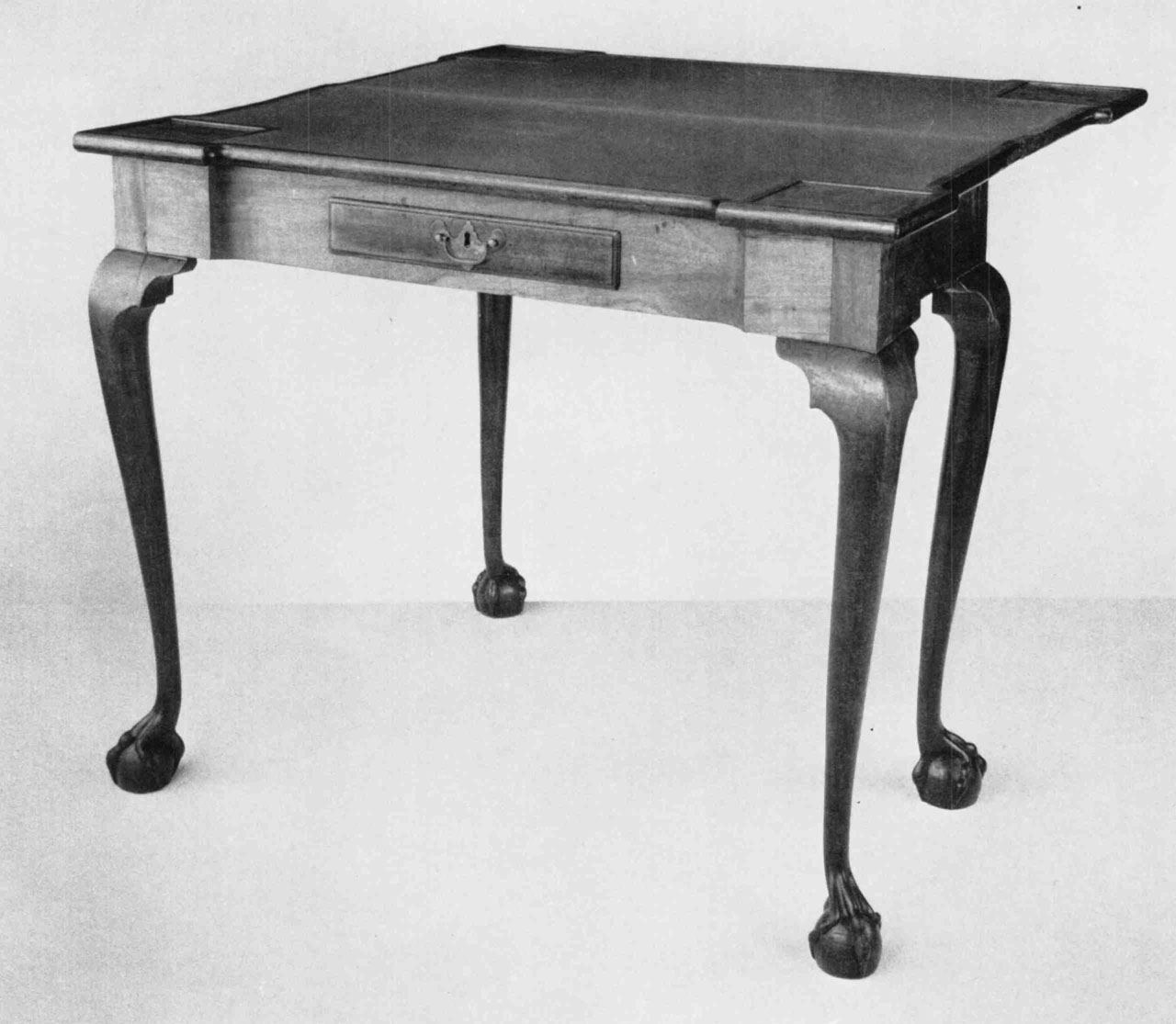
156. Card Table. Made by Benjamin Frothingham (paper label), Charlestown, c. 1755–1790. Mahogany, white pine, and maple; h. 28 inches, w. 34⅛ inches, d. 16¾ inches (closed), 33½ inches (open). (The Henry Francis du Pont Winterthur Museum.) See also fig. 157.
The second secretary, belonging to William T. Earls in 1952, is rather similar (fig. 161). It is broader in proportion and made of mahogany, but the details of the bookcase interior, the desk, and the feet are nearly identical. It is furnished with only a single middle finial, while the central opening of the bonnet is somewhat wider and rounder in proportion to the breadth of the secretary. There is also a shaped drop in the center of the skirt to accommodate the width of the piece. The mahogany is rather black, and the secondary wood is pine. It is marked with the Hurd paper label in an inside drawer.212
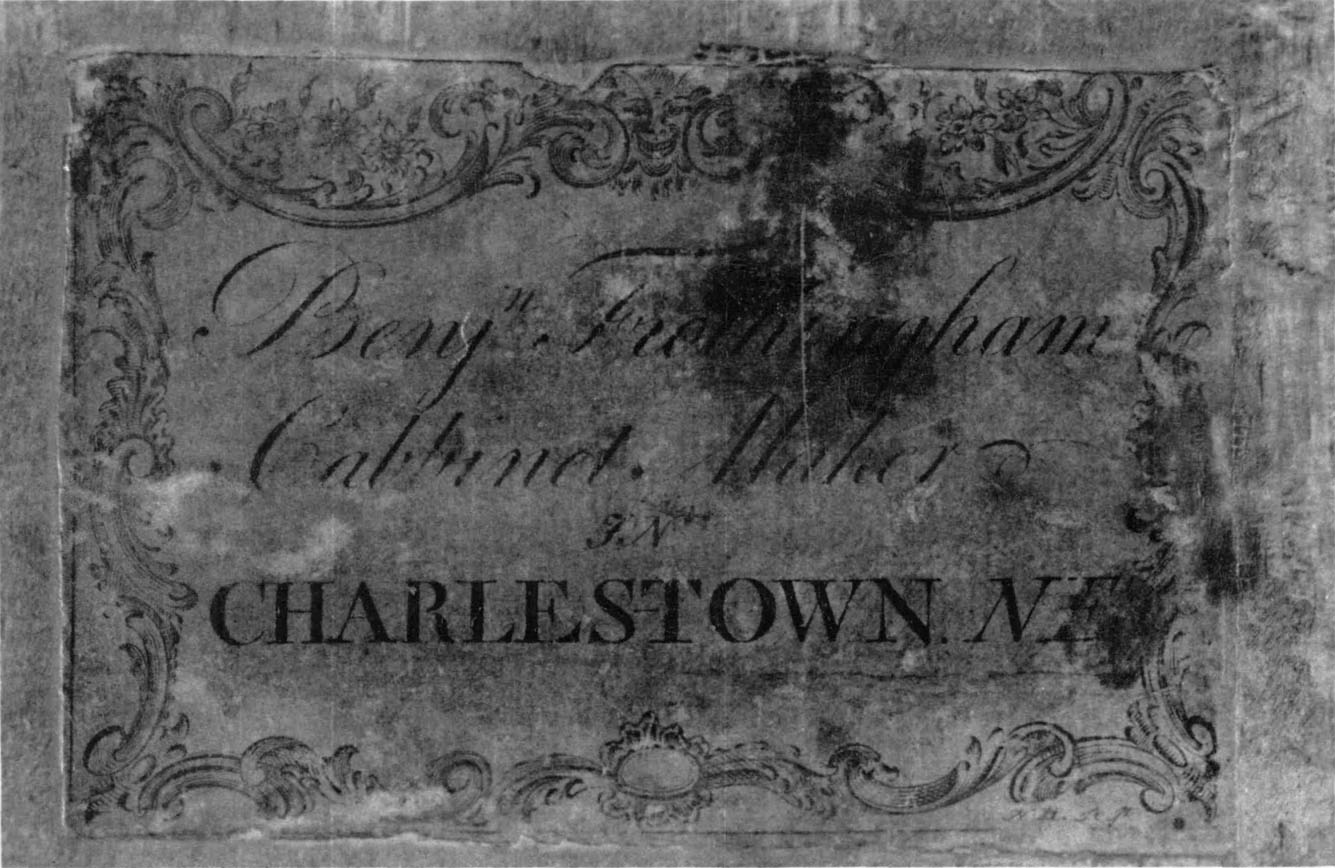
157. Detail of Paper Label on Card Table: “Benjn. Frothingham / Cabbinet Maker / IN / CHARLESTOWN. NE.” (The Henry Francis du Pont Winterthur Museum.) See also fig. 156.
The third secretary is, like the Davis-Winterthur high chest, signed on the drawers, this time in four places (figs. 97 and 162). It is an unusual mahogany bombé secretary with molded bracket feet. The bookcase upper section again has fielded panels in the doors, with round, rather than flattened arches at the top, and the bonnet is shaped like those already illustrated with three corkscrew finials. The upper case is divided by three fluted pilasters with capitals of the Corinthian order. They are richly carved with acanthus leaves against a punched ground. In the interior of the case are two intaglio fans at the top, three drawers at the bottom and a series of pigeonholes running up each side. In the center are three movable book shelves. The desk is contrived in an amphitheatre arrangement with two tiers of drawers below four pigeonholes at each side. The central door is reverse blocked with a round-headed panel. There are two narrow document drawers with plain pilasters and acorn finials. The long lower drawers have normal straight sides, and the bombé form is carried out by the shaping of the exterior of the case. Red cedar is the major secondary wood.213
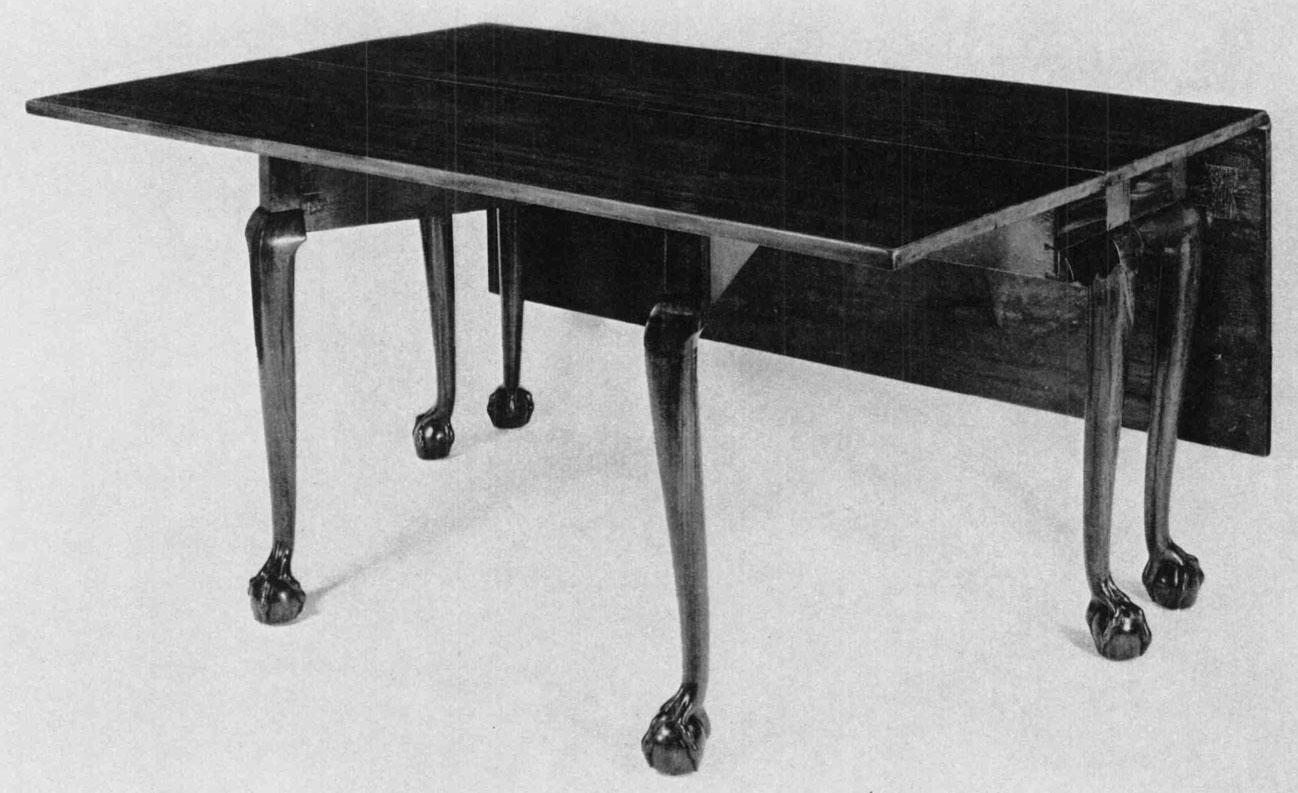
158. Dining Table. Made by Benjamin Frothingham (paper label), Charlestown, c. 1755–1790. Mahogany, maple, and white pine; h. 28⅛ inches, w. 59 inches (open), d. 60⅛ inches. (The Henry Francis du Pont Winterthur Museum.)
The signatures on the bombé secretary are interesting from several points of view. On the back of the top large drawer is the following inscription: “Do D Sprage Benj. Frothingham.” On two small interior desk drawers on the bottom is “Benj. Frothingham,” and on the side of one document drawer is “Do Sprage 1753.” The placement of the inscription on the big drawer is certainly appropriate only to those involved in the construction of the piece, and implies, since Sprage’s initials appear, that he was either a partner or workman in its construction. If the date is correct, it is the only dated example of Frothingham’s work, and is very early in his career. One might surmise that young Benjamin had gone into partnership before his father’s shop burned in 1760, and that he may have already moved from Boston to Charlestown since he is recorded there in 1754. Another possibility might be that Frothingham and Sprage were apprentices nearing the end of their training with the elder Benjamin Frothingham. The construction of the secretary could then have represented the culmination of their apprenticeships and have shown to others their mastery of the craft of cabinetmaking. A final possibility is that the signature is not that of the younger Frothingham, but that of his father. At the moment, however, since no other work attributable to the father is known, it is difficult to subtract this dated and fascinating piece from the work of the man who signed other pieces in a similar fashion. The discovery of facts relating to D. Sprage might settle the matter.214
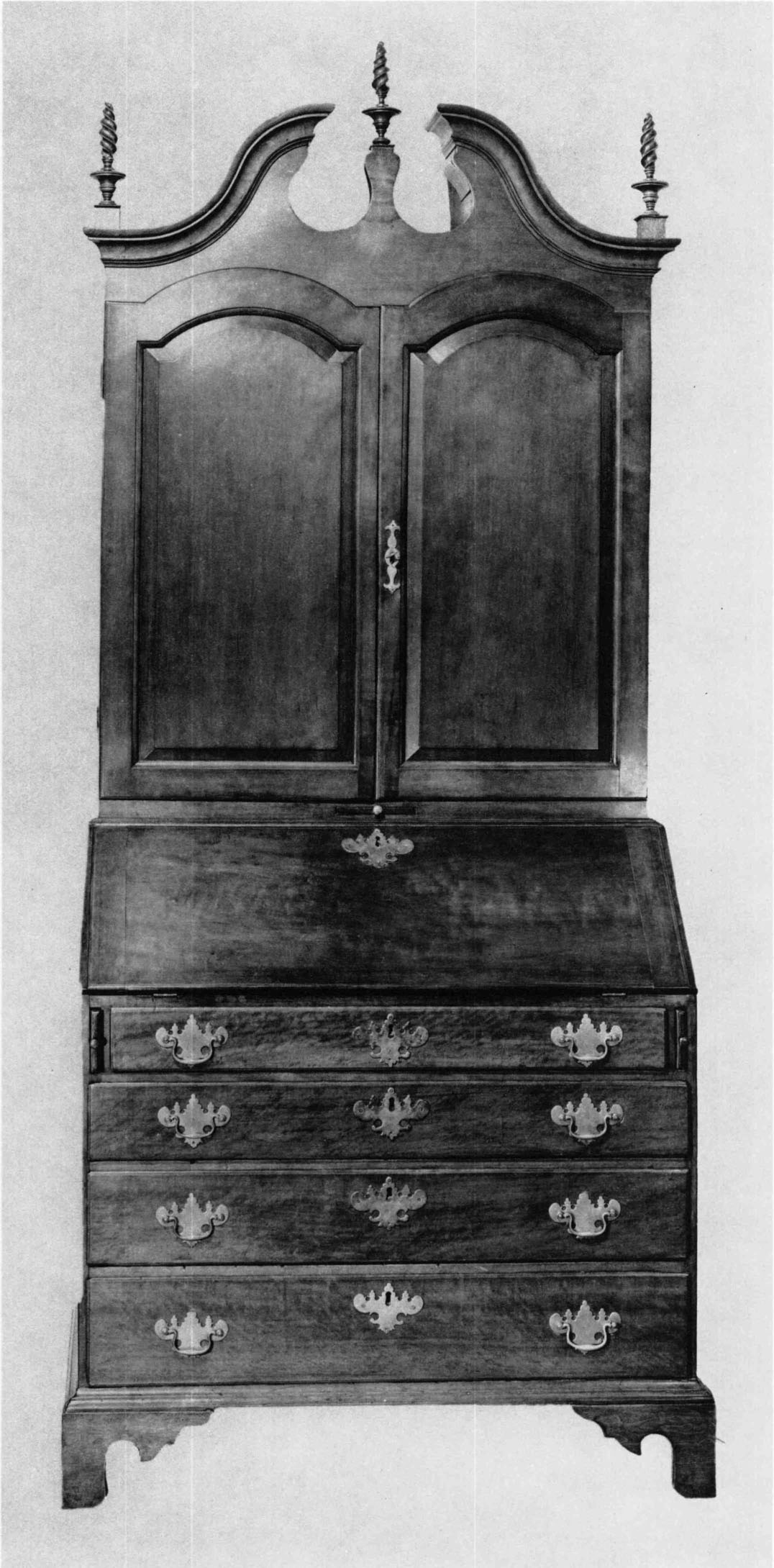
159. Desk and Bookcase. Made by Benjamin Frothingham (paper label), Charlestown, c. 1755–1790. Cherry. (Present location unknown. Formerly in the collection of Ernest Lo Nano: photo, Israel Sack, Inc., New York City.) See also fig. 160.
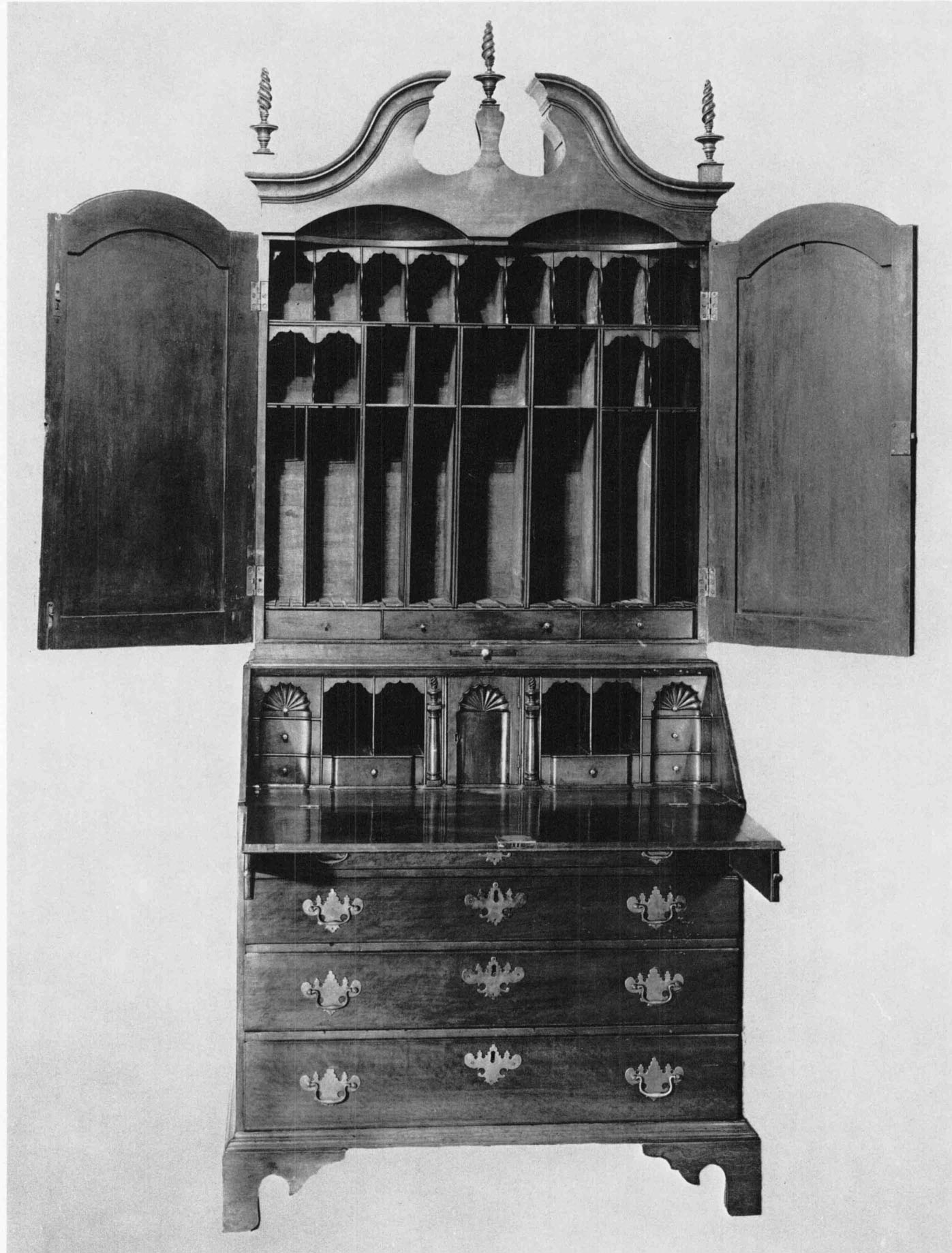
160. Interior of Desk and Bookcase. Made by Benjamin Frothingham. (Present location unknown. Formerly in the collection of Ernest Lo Nano: photo, Israel Sack, Inc., New York City.) See also fig. 159.
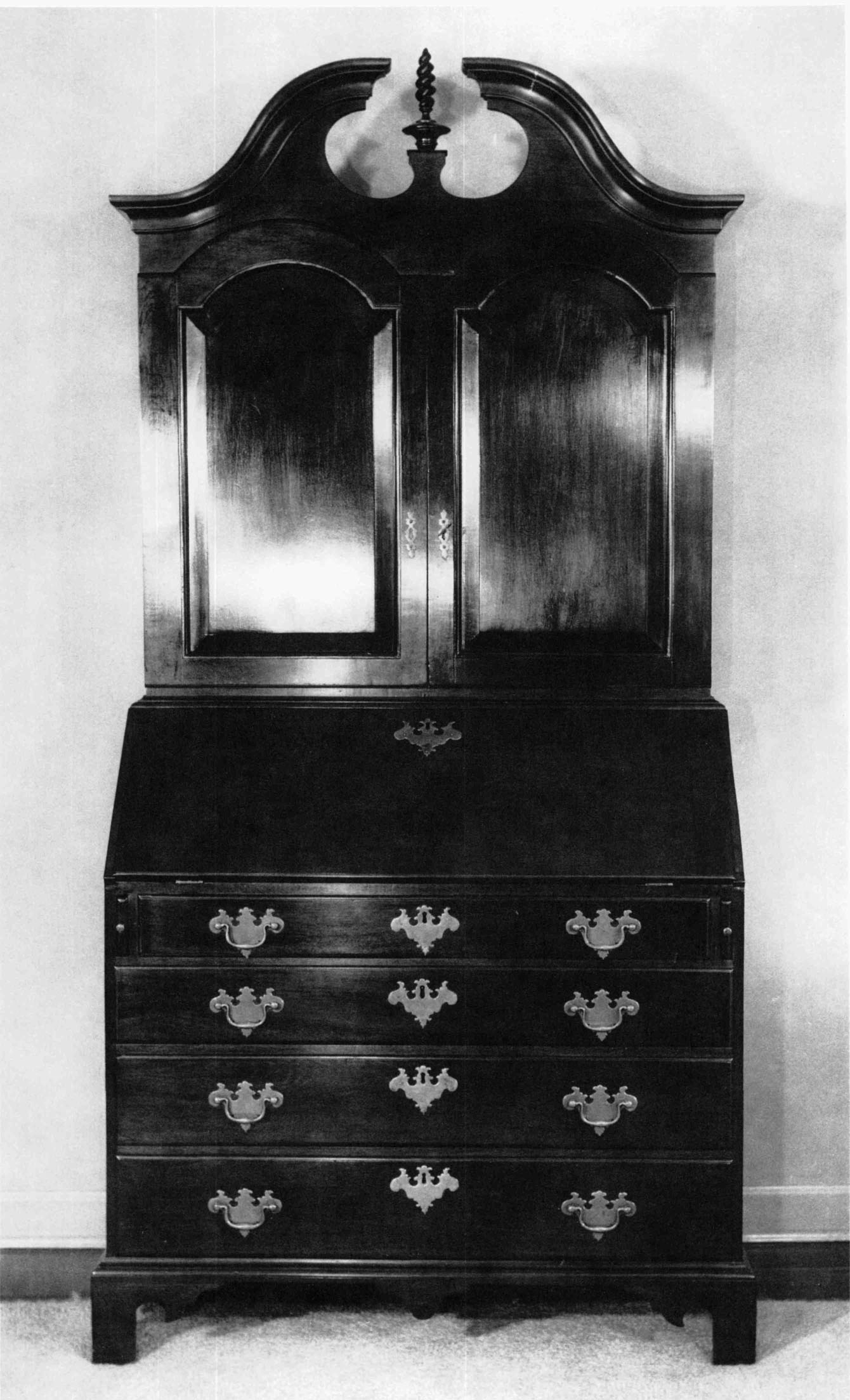
161. Desk and Bookcase. Made by Benjamin Frothingham (paper label), Charlestown, c. 1755–1790. Mahogany and white pine. (Present location unknown. Formerly in the collection of William T. Earls: photo, Antiques.)
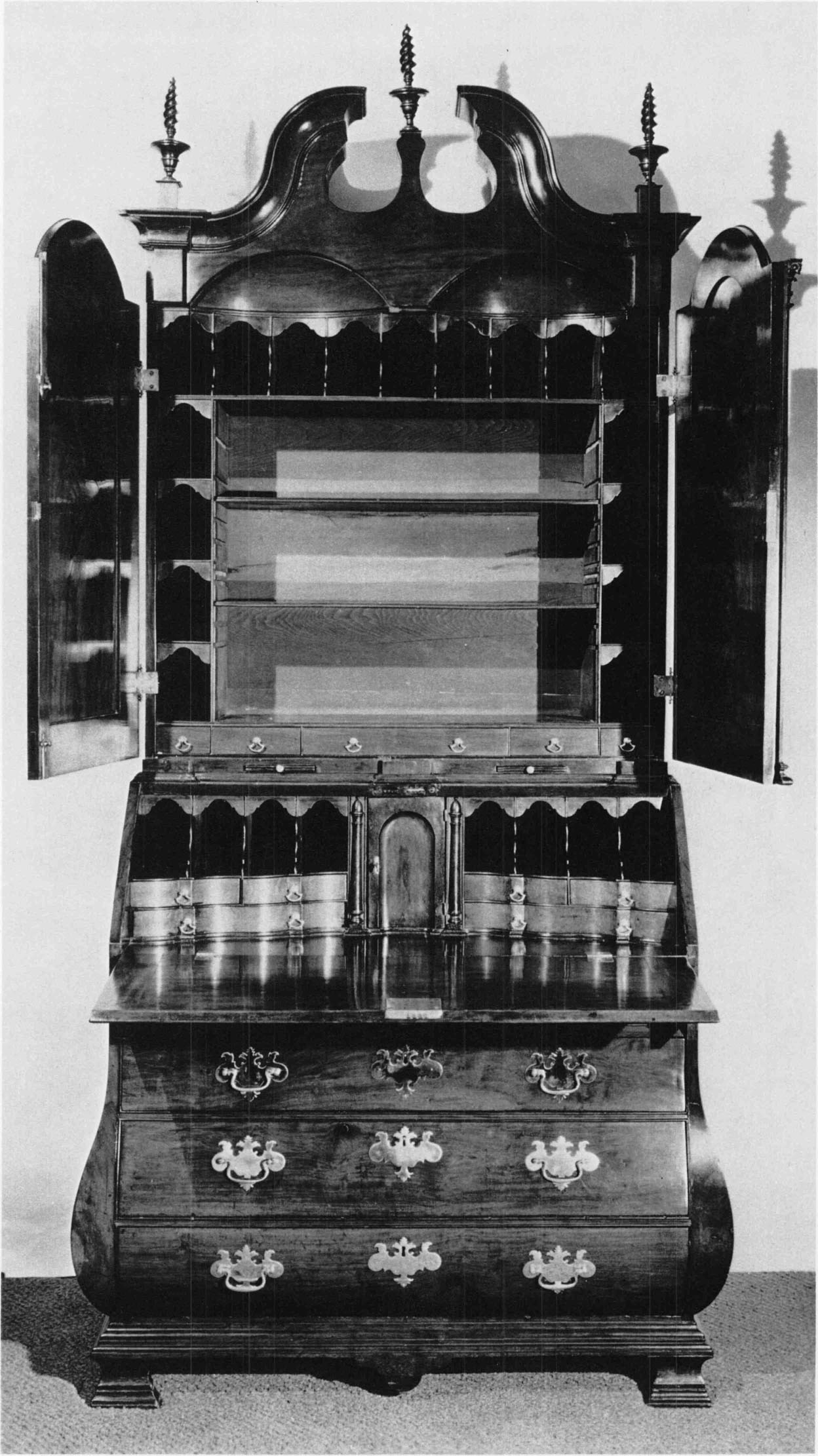
162. Interior of Desk and Bookcase. Made by Benjamin Frothingham and D. Sprage. (The Department of State, Washington, D.C.) See also fig. 97.
Frothingham employed the ogee bracket foot on occasion, as seen on three reverse serpentine mahogany desks. On the first, formerly in the collection of Mrs. Sidney Harwood (fig. 163),215 the foot has a bracket with a simple spur profile. The projecting sections of the reverse serpentine terminate with round blocking in the upper drawer and with a depressed arch in the central area. Such a treatment occurs on a desk by Joseph Hosmer of Concord216 and on a number of pieces from the Northampton area,217 as well as on a chest-on-chest with Boston details in the Henry Ford Museum.218 The interior of the desk has a projecting shelf with three drawers, above which is a pair of drawers below four ogee-headed pigeonholes on each side of the central section. The central door is treated with a reverse-blocked panel with a carved fan, and the two document drawers have plain pilasters with urn finials. The mahogany was chosen for its figure.219
Remarkably similar to the Harwood desk is a second example, now in a private collection (figs. 164 and 165). With the exception of a slight variation in the brasses and the addition of a shaped drop to the center of the skirt, this desk repeats virtually line for line the exterior shape and interior details of the Harwood desk. In addition, the blond mahogany of both desks compares quite closely in wood color and surface grain, suggesting that perhaps a single piece of mahogany was used for the drawer fronts of both pieces. According to the present owner, the second desk was purchased by her father in the Boston area about 1901. Like the Harwood desk, it bears a Hurd label in the small reverse blocked central drawer of the interior.
A third labelled desk with ogee bracket feet is in the collection of the Currier Gallery of Art (figs. 166 and 167). The shape of the brackets and brasses is reminiscent of those on the two previous desks. However, the desk front has a less pronounced bow with only a hint of blocking on the upper drawer. The desk interior also differs, containing a double tier of drawers above a row of pigeonholes. A column of three central drawers is decorated with string inlay and, on the upper drawer, with an inlaid fan. The use of inlay, a characteristic of Federal period work, suggests a date of manufacture of 1790 to 1800. A Hurd paper label appears in the middle drawer of the central section. According to David Brooke, Director of the Currier Gallery, the desk descended in the Nichols family of Wiscasset, Maine, before coming to the Gallery in 1967.
A more elaborate desk is at Historic Deerfield (figs. 78, 79, 168, and 169). It is of rich mahogany with square blocking and short cabriole legs carved with hairy claws. The desk interior duplicates that of the Lo Nano secretary. The feet are the most extraordinary features. All four feet are carved with four great talons grasping a round ball, and the fleshy parts of the foot are rendered so as to represent the effect of pin feathers. The brackets are blocked on the front and have the spur profile. The foot is smaller and more compact than the examples of hairy claw feet by George Bright and other cabinetmakers of the Boston area.220
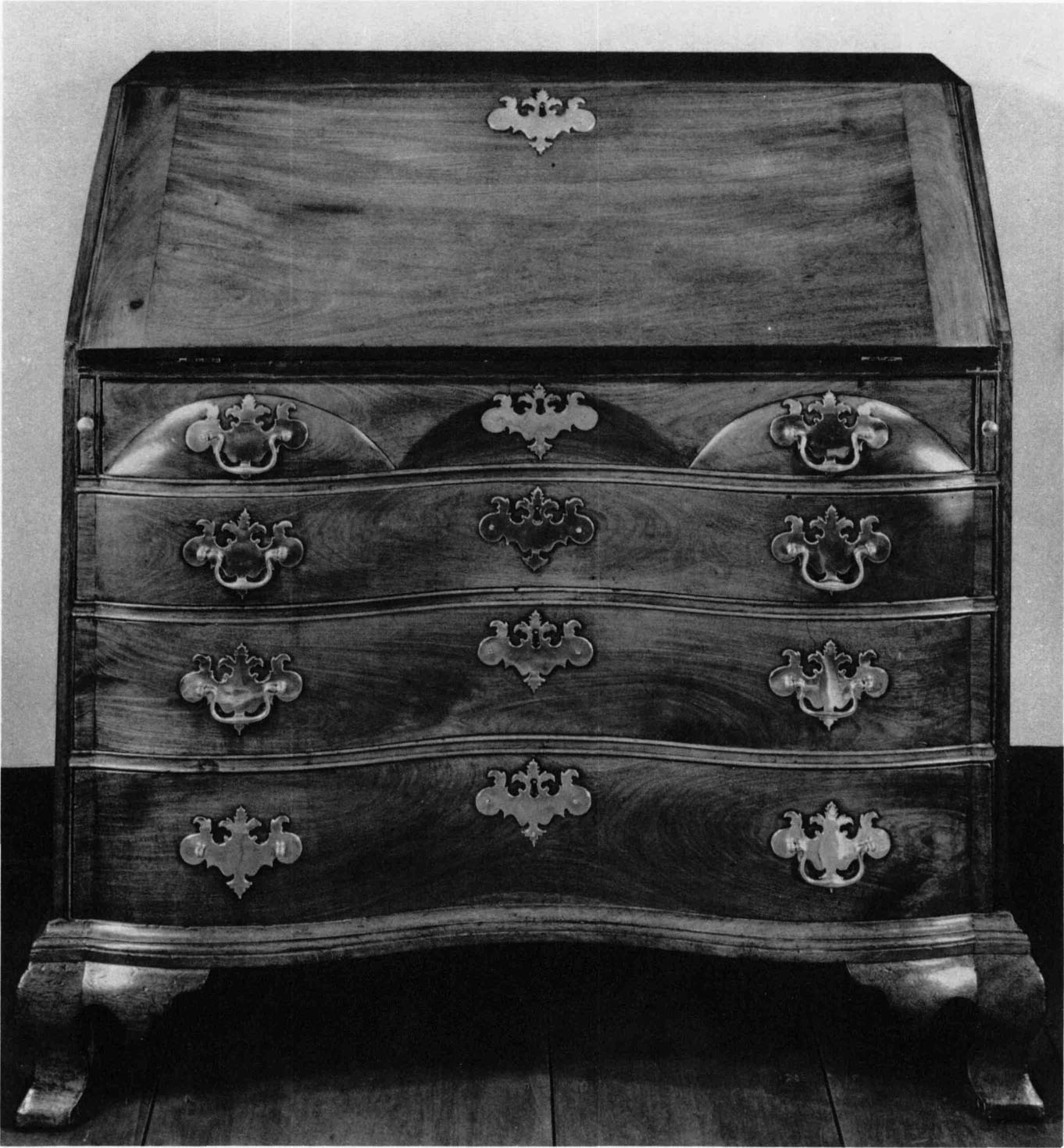
163. Desk. Made by Benjamin Frothingham (paper label), Charlestown, c. 1755–1790. Mahogany and white pine; h. 43¾ inches, w. 44½ inches, d. 23⅜ inches. (Private collection: photo, Richard Cheek.)
Two blockfront chests of drawers with plain bracket feet bear the label of Frothingham. The first example (fig. 170) has square blocking similar to the Deerfield desk; the bracket has the same spur detail seen on other examples. The top of the piece, which I have never examined, has almost no overhang, a feature unusual in Boston practice, and suggests that this might have been the base of a chest-on-chest originally. The piece bears the Hurd paper label in the drawer and was in the collection of Mrs. Ernest L. Rueter in 1952.221
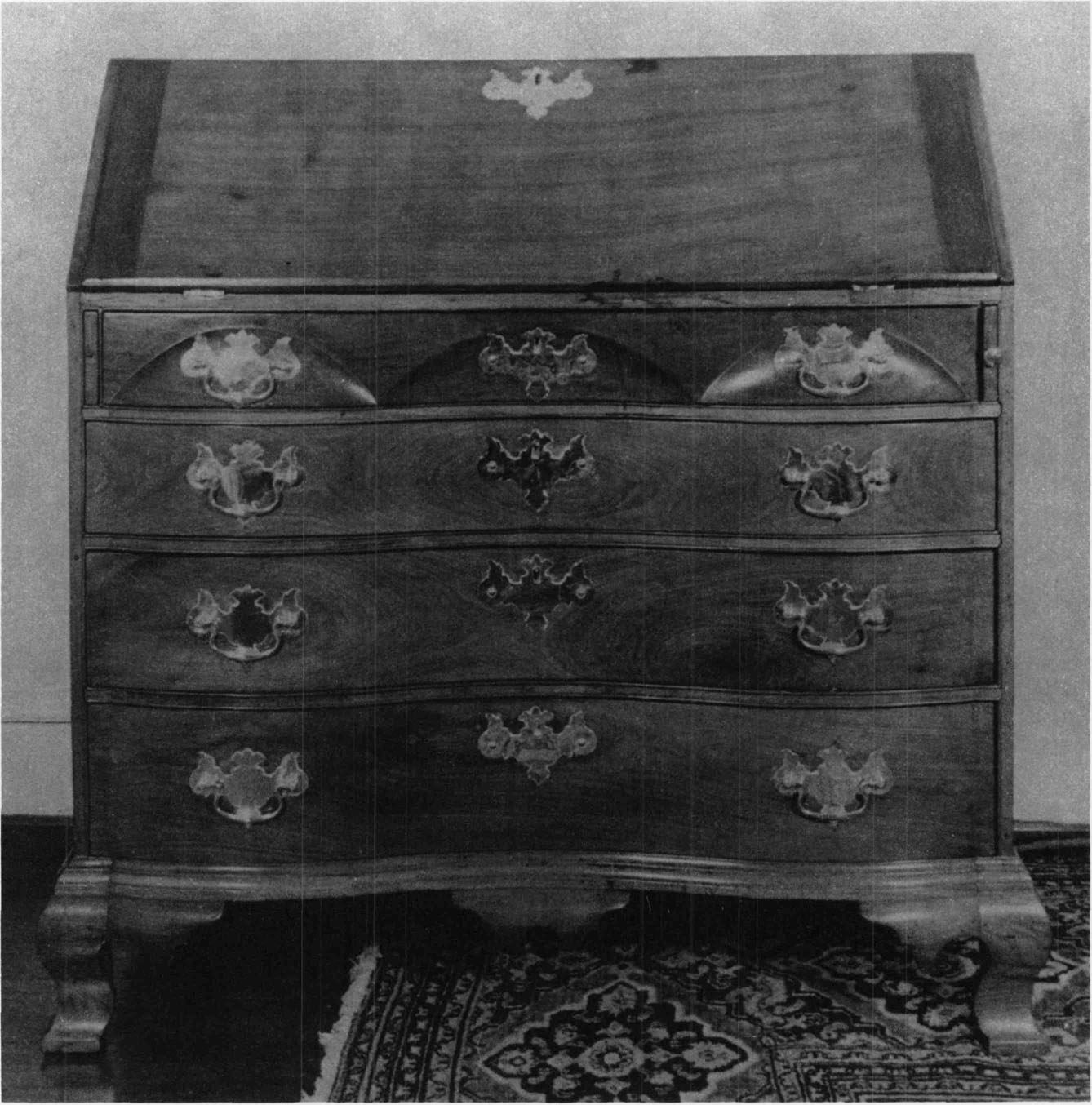
164. Desk. Made by Benjamin Frothingham (paper label), Charlestown, c. 1755–1790. Mahogany and white pine; h. 43½ inches, w. 41¾ inches, d. 21⅞ inches. (Private collection.) See also fig. 165.
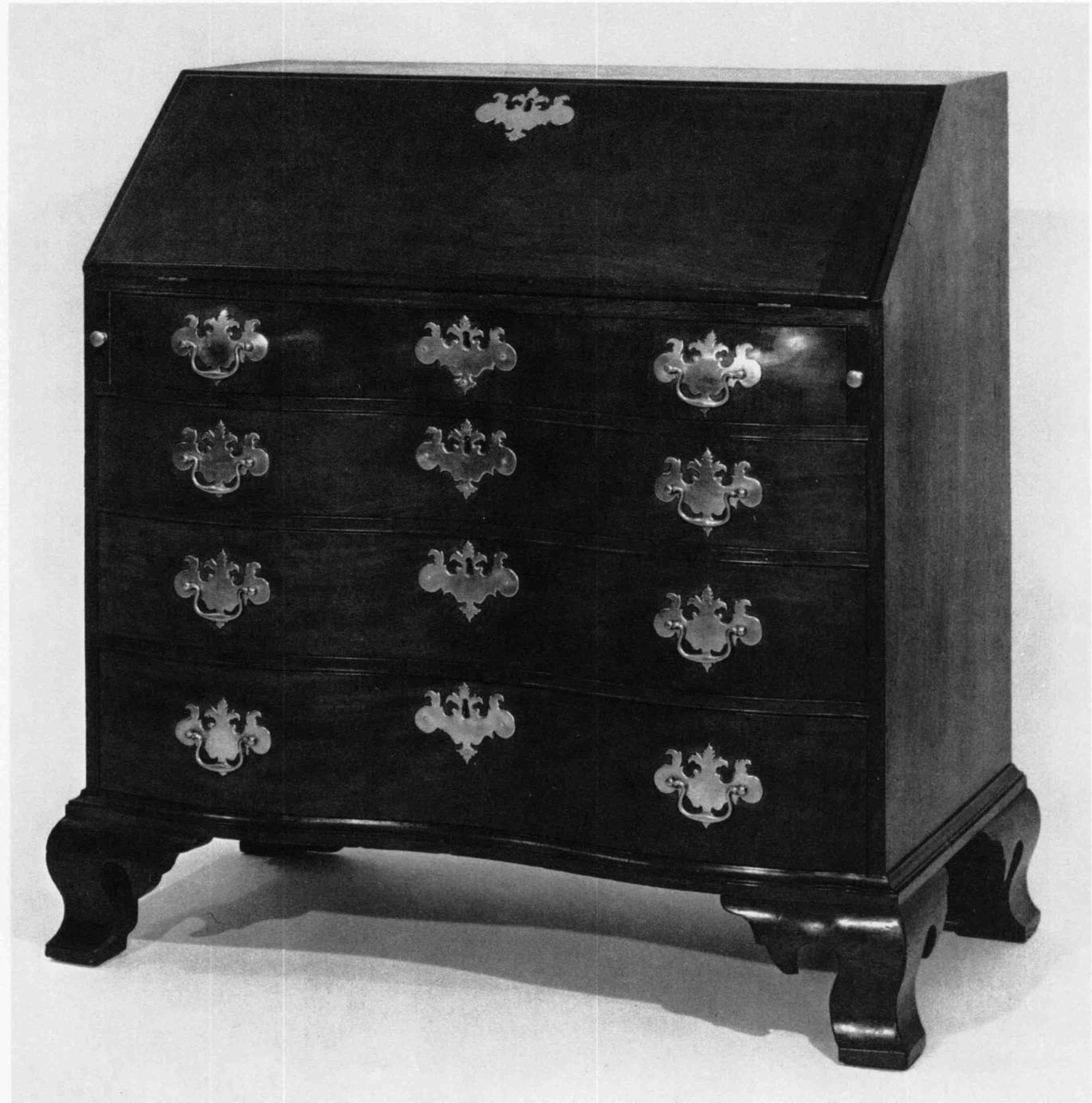
166. Desk. Made by Benjamin Frothingham (paper label), Charlestown, c. 1780–1800. Mahogany and white pine; h. 43¼ inches, w. 44 inches, d. 24 inches. (The Currier Gallery of Art.) See also fig. 167.
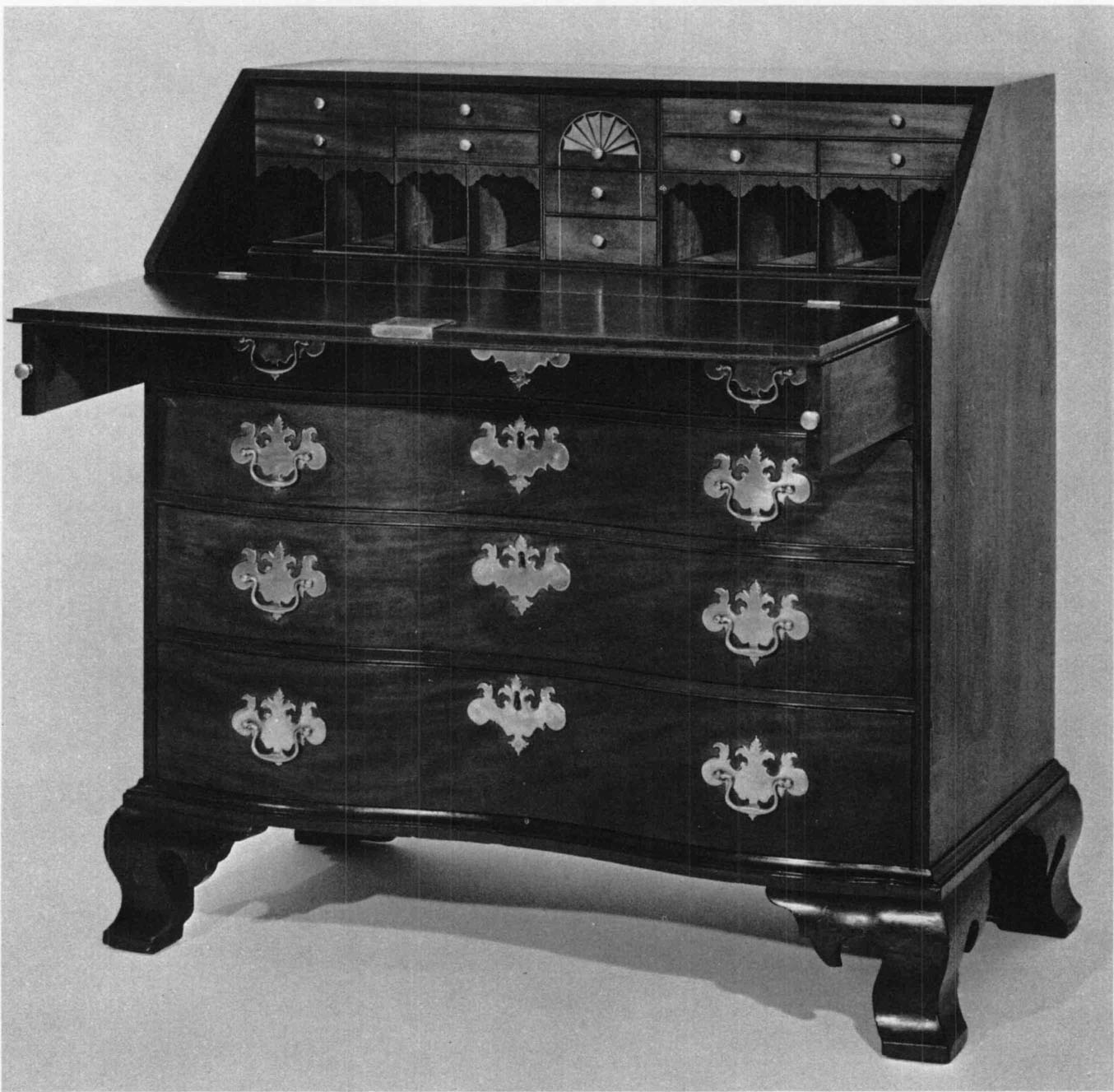
167. Interior of Desk. Made by Benjamin Frothingham. (The Currier Gallery of Art.) See also fig. 166.
The second chest, documented by a fragmentary Hurd label in the upper drawer, has rounded blocking and a molded top which follows the contours of the front. It closely resembles a chest signed in chalk by Walter Frothingham, an unidentified member of the Frothingham family. Mr. and Mrs. Stephens Croom of Mobile, Alabama, owned the chest in 1964.222
A chest-on-chest, now in a private collection, is one of the most masterful of Frothingham’s works (fig. 1). It again carries the Hurd paper label. The lower case is square blocked, and its lines carry down into a blocked ogee bracket foot of a type rarely met outside of Rhode Island. The upper case is flanked by fluted pilasters with pulvinated caps. The carved fan in the central upper drawer is of the most elaborate type found in the Boston area. It is based on stylized acanthus leaves; the main area of the fan is a leaf with undulating edges. Its surface is decorated with punched ovals and at the lower center is a smaller leaf in high relief and a row of scrolling leaves across the base. The richness of carving is continued into the open bonnet with its two floral rosettes, and the three corkscrew finials have pierced bases, giving them a weightlessness and a richness of light and shade. The lower case is supplied with side brasses, matching the large pine-tree type of the drawers.223
Having worked in the styles of the middle and third quarter of the century, Frothingham turned his attention to those of the last years of the century. He is known to have made three pieces of labelled furniture in the new neoclassical manner of Hepplewhite. One is a characteristic New England chair with an urn-decorated back, of a type made in Newport, Providence, Salem, and Boston (fig. 171). The Boston-area chairs are usually uncarved on the lower semicircle of the back splat, as is the case with this chair. The legs are molded, and across the underside of the rear seat rail is lettered “Mr Benjan. Frothingham / Charlestown” in ink. If it is not a mark of ownership, it is likely that this was the inscription of an upholsterer who wished to know to whom the chair should be returned. While it is one of only two surviving chairs associated with Frothingham, his shop inventory listed “6 chears” indicating that he had always made a certain number. The chair is owned by the Toms Foundation of Knoxville, Tennessee.224
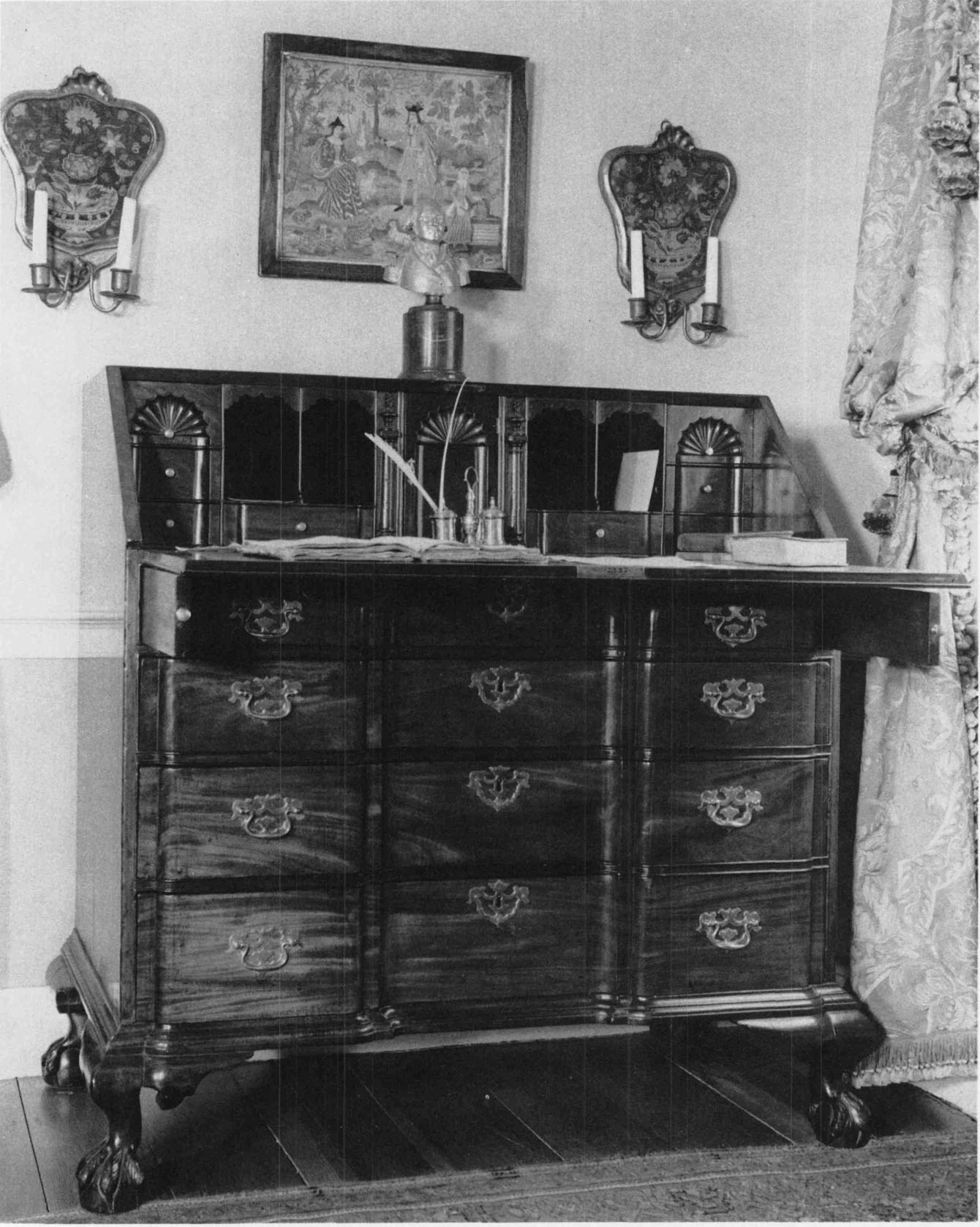
168. Desk. Made by Benjamin Frothingham. (Historic Deerfield, Inc., Deerfield, Massachusetts.) See also figs. 78, 79, and 169.
Another chair, which descended in the Frothingham family, is in the Museum of Fine Arts, Boston, and carries the legend that it was made in the shop of Benjamin Frothingham. As it is a Windsor chair, with bow back and continuous arms, it seems hardly likely to have been the product of Frothingham’s shop. Windsor chair making was a specialty in the cabinet trade; it is far more likely that Frothingham purchased the chair for his daughter. It is interesting in being a documented example of furniture which did belong to a cabinetmaker’s family.225
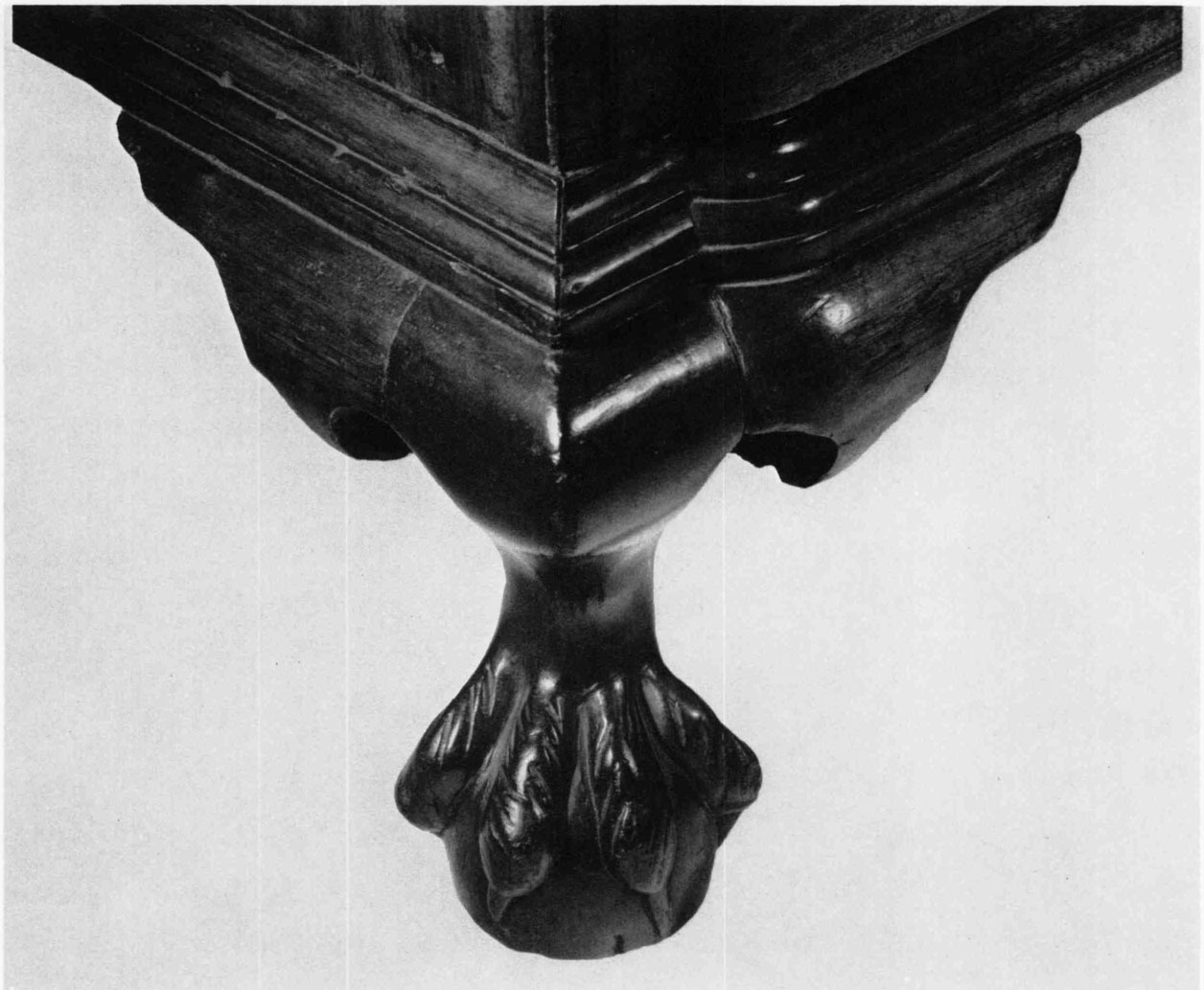
169. Detail of Foot of Desk. Made by Benjamin Frothingham. (Historic Deerfield, Inc., Deerfield, Massachusetts.) See also figs. 78, 79, and 168.
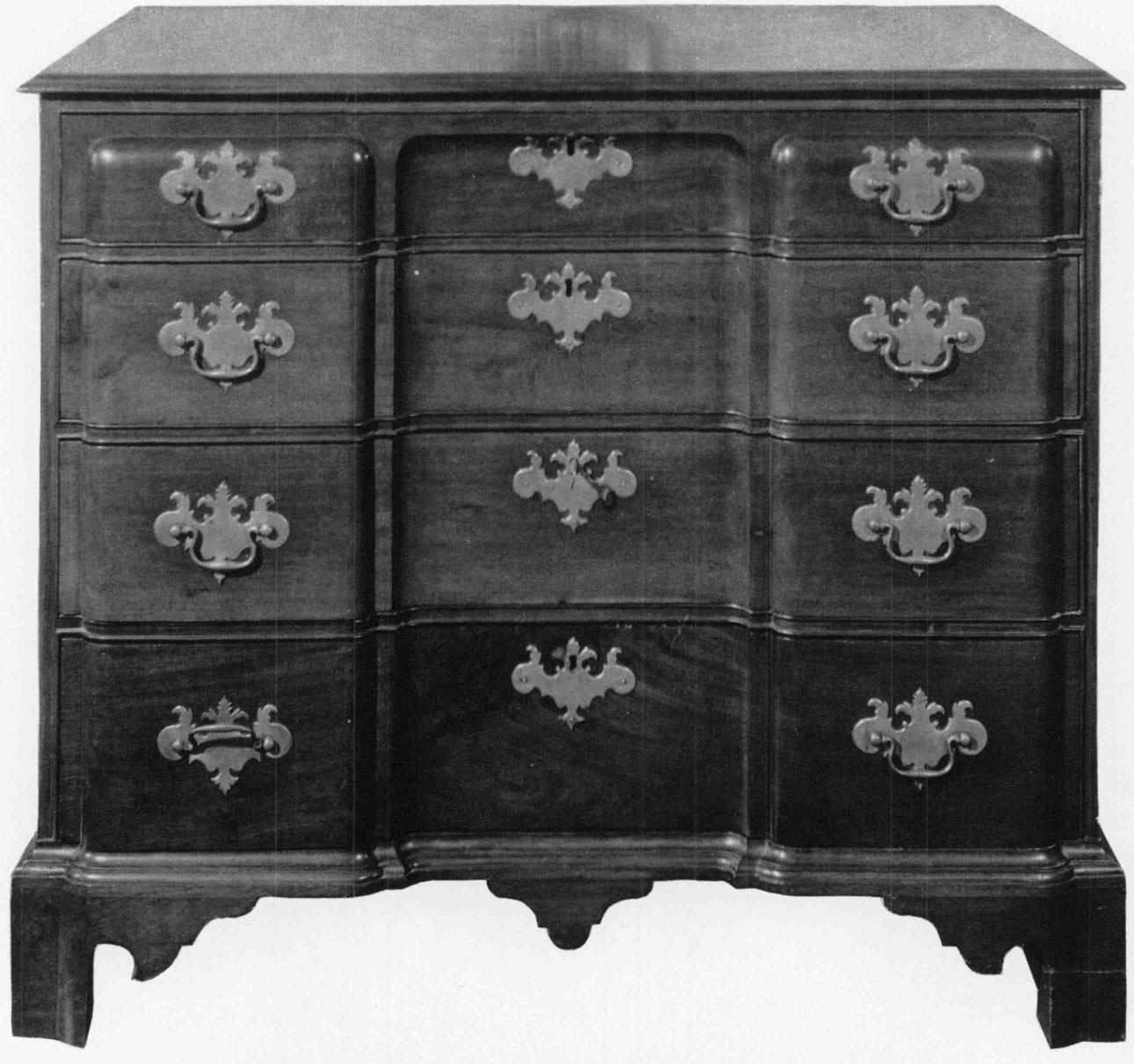
170. Chest of Drawers. Made by Benjamin Frothingham (paper label), Charlestown, c. 1755–1790. Mahogany. (Present location unknown. Formerly in the collection of Mrs. Ernest L. Rueter: photo, Antiques.)
The second neoclassical example, which has been in unknown hands since the Philip Flayderman sale of 1930 where it was lot 417, is a serpentine-front sideboard (fig. 172). The unfortunate brasses of the photograph distract one from the quality of this unusual New England board with three central drawers. The doors and drawers are well veneered and banded, with the door keyholes carried out as diamond inlays. The stiles and tapering legs have long round-headed panels of stringing, those of the legs having a single bellflower at the top of each panel. The cuffs are banded, and the top is finished with a double-beaded edge. It was described in the Flayderman catalogue as being of “Tine figured mahogany, banded with cross-cut wood of beautiful color.”226
The third example is a typical D-shaped card table in a characteristic Massachusetts manner. It has good stringing in the legs with a small panel of lighter wood at the top of the leg, and a checkered band across the bottom of the skirt. It is built of good, well-figured mahogany, but has few characteristics that indicate its origins in Frothingham’s shop, other than a finely preserved label on the underside. It is in the collection of Joseph Kindig iii.
While I do not wish to discuss the attributions to Frothingham, of which many have been made, I would like to point out that certain pieces such as the secretary in the William Rockhill Nelson Gallery with its bracket feet, similar bonnet, and identical desk interior show such affinity to Frothingham that it is hard to interpret them as merely regional similarities.227 The fall-front square blocked desk at Colonial Williamsburg again shares the general features, with minor variations in the pen drawers of the desk interior, and is one of only a few Boston-area casepieces having blocked ogee bracket feet with scroll returns. This is related to the treatment of the Frothingham chest-on-chest and bears an obvious indirect relation to Newport sources.228
Three surviving bills from Frothingham indicate the variety of work performed in his shop. On June 12, 1788, he billed Colonel
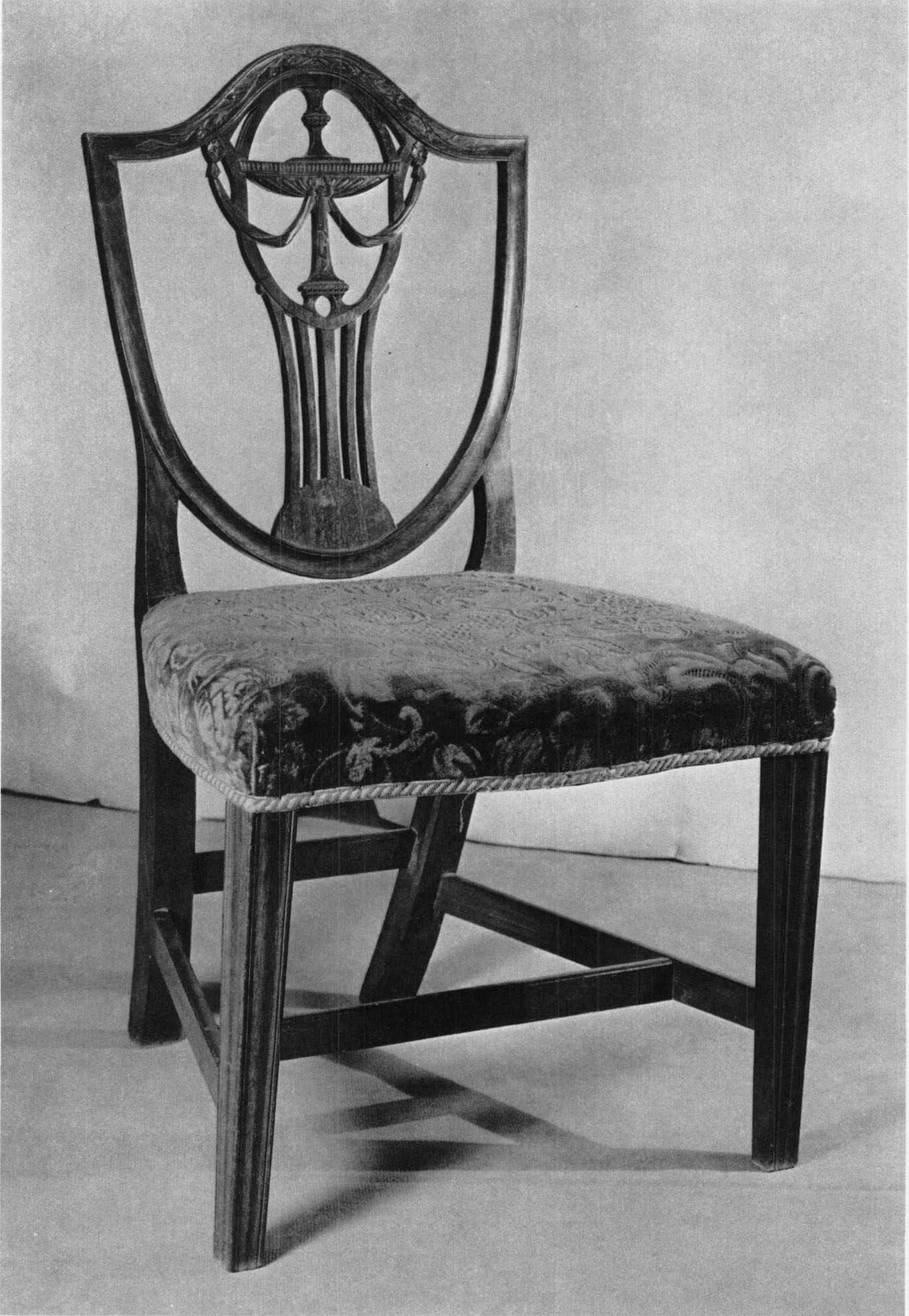
171. Side Chair. Made or owned by Benjamin Frothingham (inscription in ink), Charlestown, c. 1790–1809. Mahogany, beech, and maple; h. 33 inches, w. 22 inches, d. 18 inches. (The Toms Foundation, Craighead-Jackson House, Knoxville, Tennessee.)
Ervin for two field bedsteads, and, on April 17, 1789, William Steams for a coffin and furniture.229 On January 16, 1797, he charged General Henry Knox of Thomaston, Maine, £57:8:0 for the following:
|
To 2 large mohogany Card Tables |
£ 6:12:0 |
|
To 2 D[itt]o Do Pembrook Do |
6:12:0 |
|
To 1 large mohogany Bedsted foot & Side Boards |
12:10:0 |
|
To 1 Do without foot Board |
11: 0:0 |
|
To large mohogany ward Robe |
16:10:0 |
|
To 2 Cornish & Painting |
4: 4:0230 |
The contents of his shop, destroyed by fire in 1775, shed further light on the general size of Frothingham’s production where the following items were listed:
|
1 Mahogany Case draws |
[£] 7: 0:0 |
|
1 Burow tabel |
4: 0:0 |
|
3 Walnut Case draws |
17:10:0 |
|
12 tabels of sortes |
20: 0:0 |
|
. . . |
|
|
6 chears |
0:14:0 |
The wood inventory of the same year includes cherry and “yallowsander wood,” probably American gumwood which Frothingham’s inventory clerk put down as sandalwood because of its similar yellow color. This seems more likely than the interpretation that it was “palisander” or rosewood, which is purplish in hue. The list is as follows:
|
a Quantity of Mahogany boards & planks |
[£]34: 0:0 |
|
Walnut boards |
14: 0:0 |
|
Cherry tree boards |
1: 0:0 |
|
Mapole planks, pineboards. planks |
8: 0:0 |
|
. . . |
|
|
a Quantity of Yallowsander wood |
3:10:0231 |
While we certainly have today only a fragment of the production of Benjamin Frothingham from his career of more than fifty years, the pieces that survive with his label show a man working in the best traditions through three phases of style. He was therefore both skilled and aware of his customers’ needs. His use of unusually beautiful or colored woods—plum pudding mahogany, cherry, and “yallowsander”—indicate either that there may have been some differences in taste between Boston and Charlestown or that the cabinetmaker himself enjoyed unusual woods. His choice of brasses, also, judging from the evidence of two sets of pierced ones, is something more than ordinary.
However, it is very difficult to attribute the richness of taste in details to the cabinetmaker of the eighteenth century. The taste was more often that of the customer. While we know a certain amount about Frothingham, we have, except for three bills, very little knowledge of his clientele. For them it appears that he produced mostly casepieces—desks, secretaries, and chests of drawers—though tables formed a good portion of his 1775 inventory and account for two of his surviving pieces. That he also made chairs is implied by the inventory and affirmed by the Hepplewhite shield-back example.
A number of details remain to be discovered. Who was the I. Gold whose name appears on the brasses of the Davis-Winterthur examples, and who was the D. Sprage who signed the bombé secretary? To judge from the majority of his cabinetwork, it would be interesting to know if he was a carver himself or if, more likely, he employed a carver to produce the elaborate fan of the privately owned chest-on-chest and the hairy paw feet of the Deerfield desk.
Certainly, Major Benjamin Frothingham was a man well known and honored in his own day. He was also financially successful. His claims of 1775 show that he owned a shop valued at £26, a barn at £40, and a house of £220 value. In 1809 he died possessed of twenty-seven square rods of land and a building valued at $2500. He has left behind what many other Boston-area makers have denied us, a series of labelled examples ranging from the mid-eighteenth century to the early nineteenth century. While this tells much about Frothingham as an individual, it tells an equal amount about his contemporaries in Boston and vicinity, and what one may expect to have emerged from their shops. There has yet to be discovered a daybook of a Boston maker, where one can learn the day-to-day business of the cabinetmaker as that of the silversmith is outlined by Paul Revere’s accounts. However, the labelled furniture of Frothingham comes closest to showing the range and variety of the Boston cabinetmaker’s work.
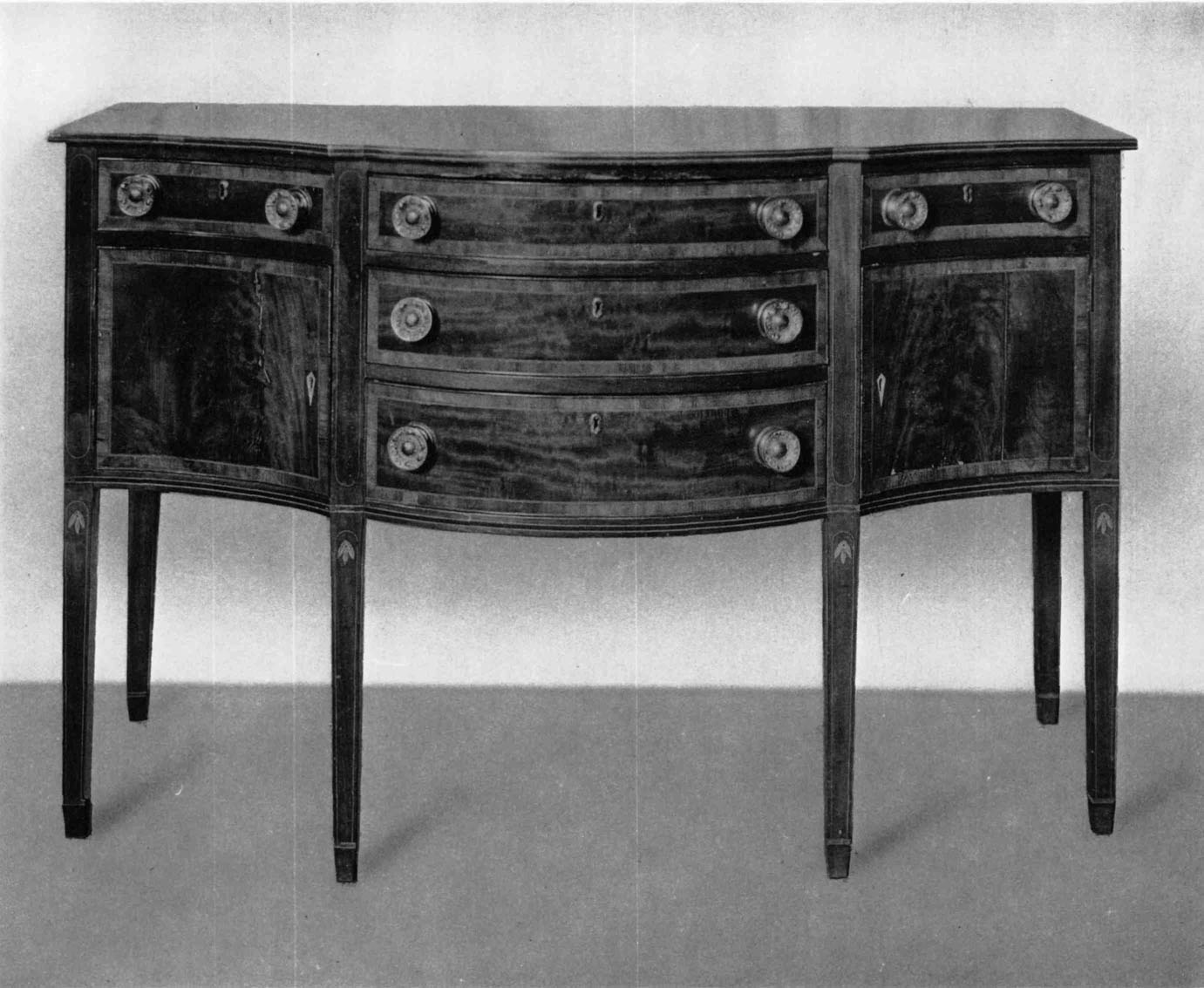
172. Sideboard. Made by Benjamin Frothingham (paper label), Charlestown, c. 1790–1809. Mahogany and white pine; h. 38 inches, w. 59 inches, d. 25 inches. (Present location unknown. Sold at the American Art Association auction of the estate of Philip Flayderman, January 2–4, 1930, lot 417: photo, Antiques.)

